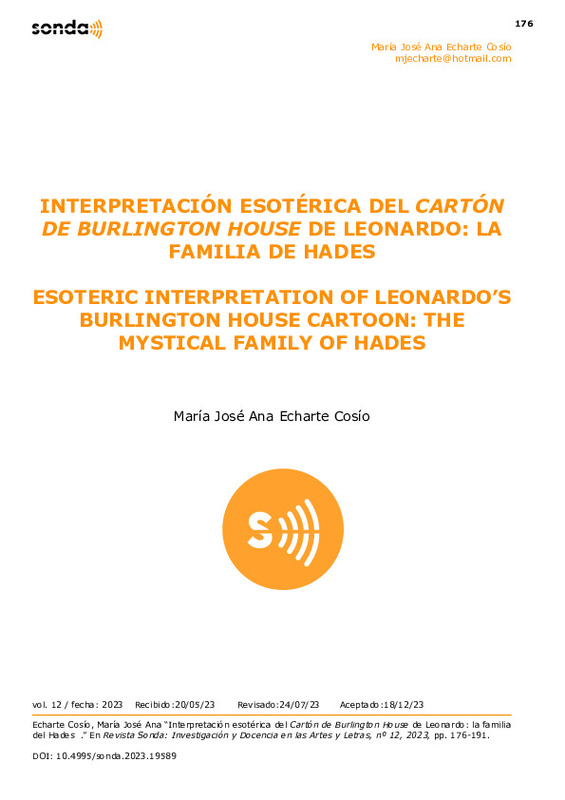- RiuNet repositorio UPV
- :
- Investigación
- :
- Material investigación. Editorial UPV
- :
- Revistas UPV. Editorial UPV
- :
- Revista Sonda: Investigación en Artes y Letras
- :
- Revista Sonda: Investigación y Docencia en Artes y Letras - Vol. 12 (2023): La producción artística; un reto colectivo en proceso de cambio y corrección permanente
- :
- Ver ítem
JavaScript is disabled for your browser. Some features of this site may not work without it.
Buscar en RiuNet
Listar
Mi cuenta
Estadísticas
Ayuda RiuNet
Admin. UPV
Interpretación esotérica del Cartón de Burlington House de Leonardo: la familia de Hades
Mostrar el registro sencillo del ítem
Ficheros en el ítem
| dc.contributor.author | Echarte Cosío, María José Ana
|
es_ES |
| dc.date.accessioned | 2024-02-20T11:43:21Z | |
| dc.date.available | 2024-02-20T11:43:21Z | |
| dc.date.issued | 2024-01-18 | |
| dc.identifier.uri | http://hdl.handle.net/10251/202728 | |
| dc.description.abstract | [EN] We start with an attempt of multidisciplinarity with the application of Classical Culture to the artistic context that we analyze. We propose an esoteric interpretation. We use a structural method, a signifier, a meaning, but divided into two modes of meaning, superficial and deep: in the superficial plane the Virgin with the Child and Santa Ana with San Juan are opposed; in the deep plane, to which we dedicate our preferential attention, we study the structure that underlies its superficial treatment, that is: the classic myth of those known as The Goddesses or The Two Goddesses , the Eleusinian goddesses, that is, Demeter (archetype of the Mother)-Persephone (archetype of the Daughter) in indestructible Unity, with the divine Child Dionysus (primordial child) and John the Baptist-child. Leonardo s own life is involved, in the relationship with his mother, within which Leonardo s dream with a Bird of Prey is inserted. Androgyny constitutes an important element inthe configuration of the work. | es_ES |
| dc.description.abstract | [ES] Partimos de un intento de multidisciplinariedad, con la aplicación de la Cultura Clásica al contexto artístico que analizamos. Proponemos una interpretación esotérica con un método estructural, a un significante un significado, pero escindido en dos modos de significar, superficial y profundo: en el plano superficial se oponen la Virgen con el Niño y Santa Ana con San Juan Bautista; en el plano profundo, al que dedicamos nuestra atención preferente, estudiamos la estructura que subyace a su tratamiento superficial, esto es: el myto¹ clásico de Las Diosas o Las dos Diosas , las diosas eleusinas: Deméter (arquetipo de la Madre)-Perséfone (arquetipo de la Hija) en indestructible Unidad, junto con el Niño divino Dioniso (niño primordial) y Juan el Bautista-niño. Queda implicada la propia vida de Leonardo, en la relación con su madre, dentro de la que queda inserto el sueño de Leonardo con un Ave Rapaz. El andrógino constituye un elemento esencial en la configuración de la obra. | es_ES |
| dc.language | Español | es_ES |
| dc.publisher | Universitat Politècnica de València | es_ES |
| dc.relation.ispartof | Revista Sonda. Investigación en Artes y Letras | es_ES |
| dc.rights | Reconocimiento - No comercial - Compartir igual (by-nc-sa) | es_ES |
| dc.subject | Art | es_ES |
| dc.subject | Classic Culture | es_ES |
| dc.subject | Demeter-Persephone | es_ES |
| dc.subject | Primordial serpent | es_ES |
| dc.subject | Arte | es_ES |
| dc.subject | Cultura Clásica | es_ES |
| dc.subject | Deméter-Perséfone | es_ES |
| dc.subject | Serpiente primordial | es_ES |
| dc.title | Interpretación esotérica del Cartón de Burlington House de Leonardo: la familia de Hades | es_ES |
| dc.title.alternative | Esoteric interpretation of Leonardo's Burlington House Cartoon: the mystical family of Hades | es_ES |
| dc.type | Artículo | es_ES |
| dc.identifier.doi | 10.4995/sonda.2023.19589 | |
| dc.rights.accessRights | Abierto | es_ES |
| dc.description.bibliographicCitation | Echarte Cosío, MJA. (2024). Interpretación esotérica del Cartón de Burlington House de Leonardo: la familia de Hades. Revista Sonda. Investigación en Artes y Letras. 12:176-191. https://doi.org/10.4995/sonda.2023.19589 | es_ES |
| dc.description.accrualMethod | OJS | es_ES |
| dc.relation.publisherversion | https://doi.org/10.4995/sonda.2023.19589 | es_ES |
| dc.description.upvformatpinicio | 176 | es_ES |
| dc.description.upvformatpfin | 191 | es_ES |
| dc.type.version | info:eu-repo/semantics/publishedVersion | es_ES |
| dc.description.volume | 12 | es_ES |
| dc.identifier.eissn | 2254-6073 | |
| dc.relation.pasarela | OJS\19589 | es_ES |








